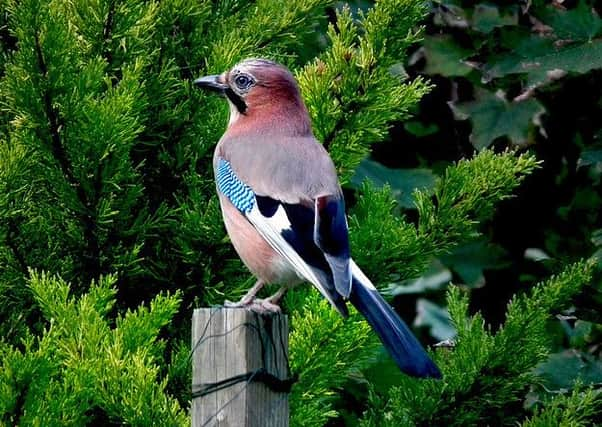A beautiful, shy and retiring bird...


We only ever got a fleeting glimpse as this colourful visitor to the garden managed to evade every attempt by us to identify it.
Jays are strikingly coloured members of the crow family, found throughout England and Wales. During spring, gatherings of jays, known as ‘crow marriages’, take place in which individuals search for a mate.
Advertisement
Hide AdAdvertisement
Hide AdJays love acorns, which they store up during autumn and revisit during harder times. A single bird buries several thousand each year, and in doing that they play a crucial role in the spread of oak woodlands - something that Londonderry is famous for the world over. When threatened by hawks, the usually shy jays mob their attackers, mimicking the hawk’s call as an alarm.


About the same size as a Jackdaw they are mostly a pinkish brown, and underneath are slightly paler. The head has a black and white flecked crown, they have a black moustache and white throat. The white rump contrasts starkly with the black tail.
The iris of the eye is a pale blue, the bill is black and the legs are pink-brown. The wings are mostly black with white patches but also have striking blue patches, but close to these wing patches are actually bands of graduated shades of blue.
On a website for garden birds I found the folowing information... Jays are very sociable birds and so have many different calls, and can imitate other birds, especially other crows. In the garden, we are more likely to hear their ‘krar krar’ alarm call.
Advertisement
Hide AdAdvertisement
Hide AdDuring the latter part of the winter, you may be lucky enough to hear their song, which comprises squeaky, clucking sounds.
Jays feed on acorns, beech mast, fruits, insects, small rodents, bats, newts, birds’ eggs and young birds. In the garden they will take peanuts and kitchen scraps.
Food, especially acorns, is hoarded and may be hidden in crevices or buried in the ground.
During the spring the Jays build an untidy nest of twigs, both birds getting involved in the task, and the nests can be found in a tree or shrub. Roots, hairs and fibres are used to line the nest. The male and female usually pair for life.
Advertisement
Hide AdAdvertisement
Hide AdThe eggs of the Jay are about 32mm by 23mm in size, and are smooth, glossy, and pale blue-green or olive with buff-coloured speckles. The duties of incubating the eggs are performed by the female. The newly-hatched young are fed by both adults.
The bird is resident right across the UK and Ireland with the exception of the furthest aspect of the Scottish Highlands and the west of the Province of Connaught